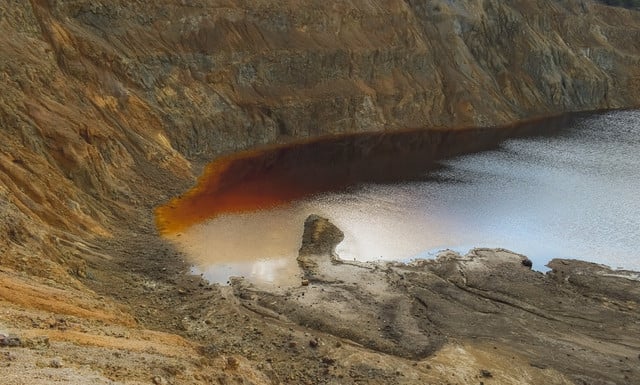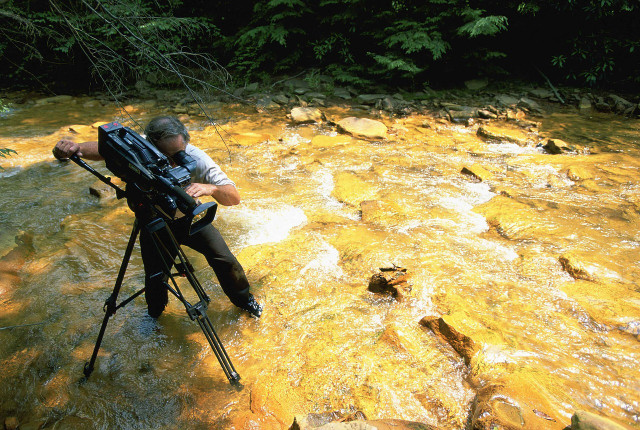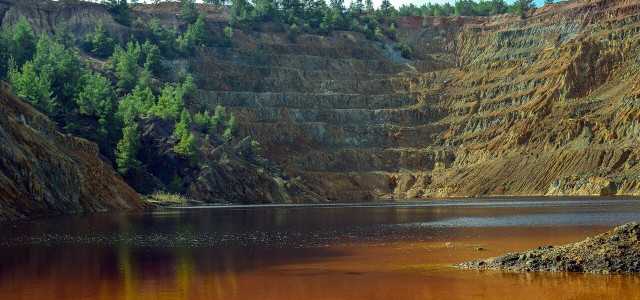Acid mine drainage is highly acidic waste from mining sites that has detrimental environmental and economic effects. Keep reading to find out why it is such a big threat.
What Is Acid Mine Drainage and What Causes It?
Acid mine drainage is one of mining’s most serious threats to nature. Research shows that acid mine drainage creates serious environmental pollution due to its high acidity, sulfate contents and toxic metals. The US Environmental Protection Agency has determined that acid mine drainage is currently the main water pollutant in the mid-Atlantic region’s surface waters. According to the Associated Press, US mine sites pour 50 million gallons of aresenic- and lead-contaminated water into surrounding bodies of water.
Acid mine drainage is a highly acidic and metal-rich solution, that is formed when pyrite (an iron sulfide), is exposed at metal mines and reacts with air and water to form sulphuric acid. Sulphuric acid can dissolve other harmful metals and metalloids (like arsenic) from the surrounding rock. Acid mine drainage can be released anywhere in the mine where sulfides are exposed to air and water, including waste rock piles, open pits, and underground tunnels. Soil that is exposed to acid mine drainage becomes structurally unstable and prone to erosion. Acid mine drainage also dissolves toxic metals, which form an orange/yellow substance known as yellowboy, which coats the bottom of streams. It is very toxic to both humans and wildlife.
What Is the Damage Caused?

(Foto: CC0 / Pixabay / dimitrisvetsikas1969)
Acid mine drainage is especially harmful because it can occur indefinitely — long after mining has ended. The negative environmental impacts depends on the severity of the pH change of the water. Many impacted streams have a pH of 4 or lower, which is similar to battery acid. The environmental problems that are associated with mine drainage include:
- Contaminated Drinking Water: Mine drainage is not just an ecological concern but an economic concern, as water treatment can be a significant economic burden to the public if a company does not cover water treatment costs. The Zortman Landusky mine in Montana, which operated from 1979 to 1998, has experienced over 12 cyanide spills, including one spill that released 50,000 gallons of cyanide solution and contaminated a community drinking water supply.
- Disruption of Aquatic Life: A 2021 study concluded that when left untreated, acid mine drainage can cause severe environmental degradation, including killing aquatic life and toxifying their natural habitat.
- Economic Impacts: The economic damage caused by acid mine drainage is huge. This often occurs when mining companies go bankrupt and cannot afford to clean up the site. At the Summitville Mine in Colorado, acid mine drainage killed all biological life within 17 miles of the Alamosa River, and after the mining company walked away, taxpayers are left footing a $30,000 bill per day to treat the damage.
What Can Be Done?



(Foto: CC0 / Pixabay / PublicDomainImages)
Unfortunately, in some cases, treatment of acid mine drainage cannot be successful, as once reactions begin, they are almost impossible to stop. But luckily, there are a variety of approaches to limiting acid mine drainage. Some of the various innovations include:
- Neutralizing the Acidity: Lime or other alkaline materials such as sodium hydroxide and sodium carbonate are often added to the body of water to reduce the acidity directly.
- Diverting wate:. This is done to prevent water from running through mining sites by using pipes and slope changes in the affected area.
- Creating Artificial Wetlands: Natural microbial processes are encouraged in the affected areas in attempts to precipitate out some of the dissolved metals.
- Reverse Osmosis: Spongy membranes allow water to pass through but retain heavier particles.
Read on:
- Plastic Pollution in the Ocean: What Can I Do About It?
- What is Glitter Made of and Does it Harm the Environment?
- Cigarette Butts are The World’s Most Littered Plastic Item. Are They Biodegradable?
Do you like this post?






